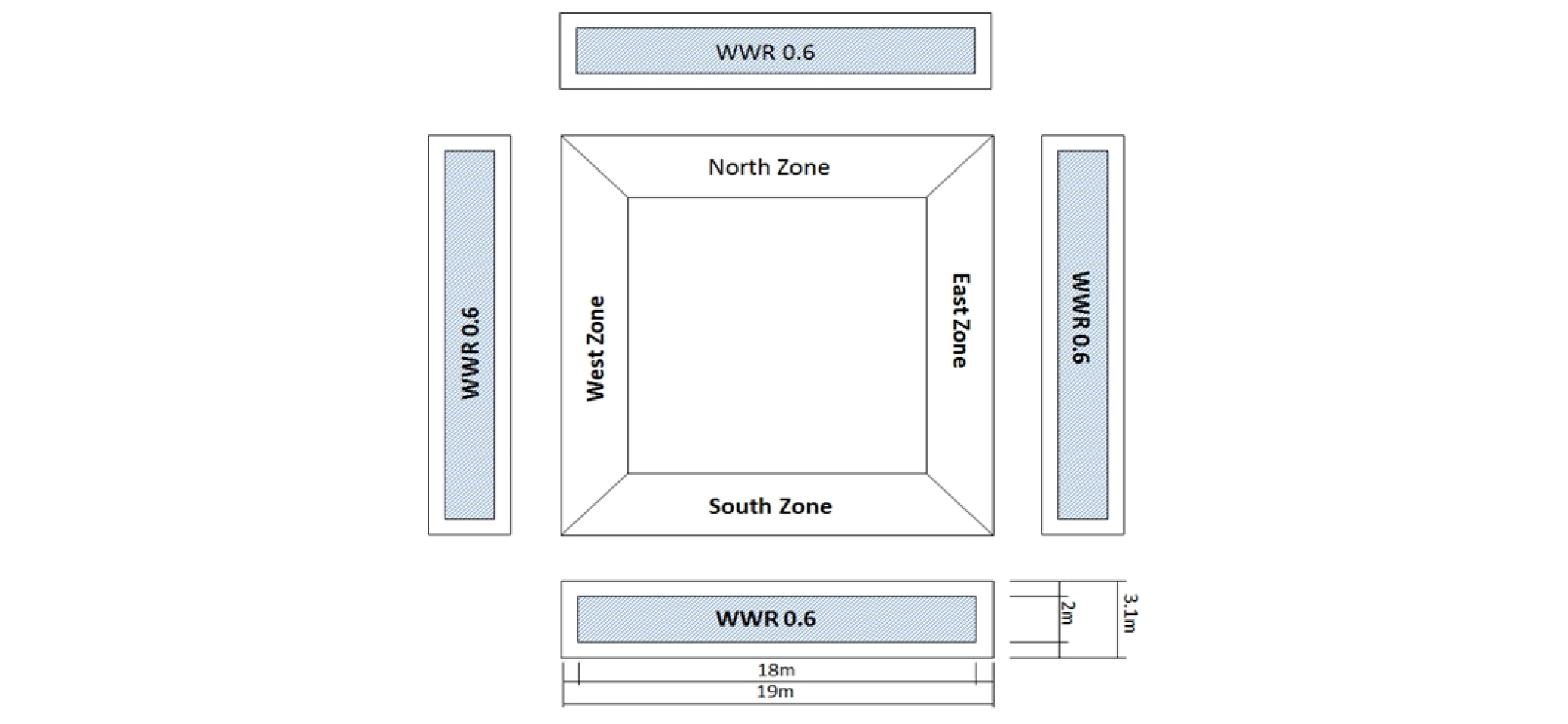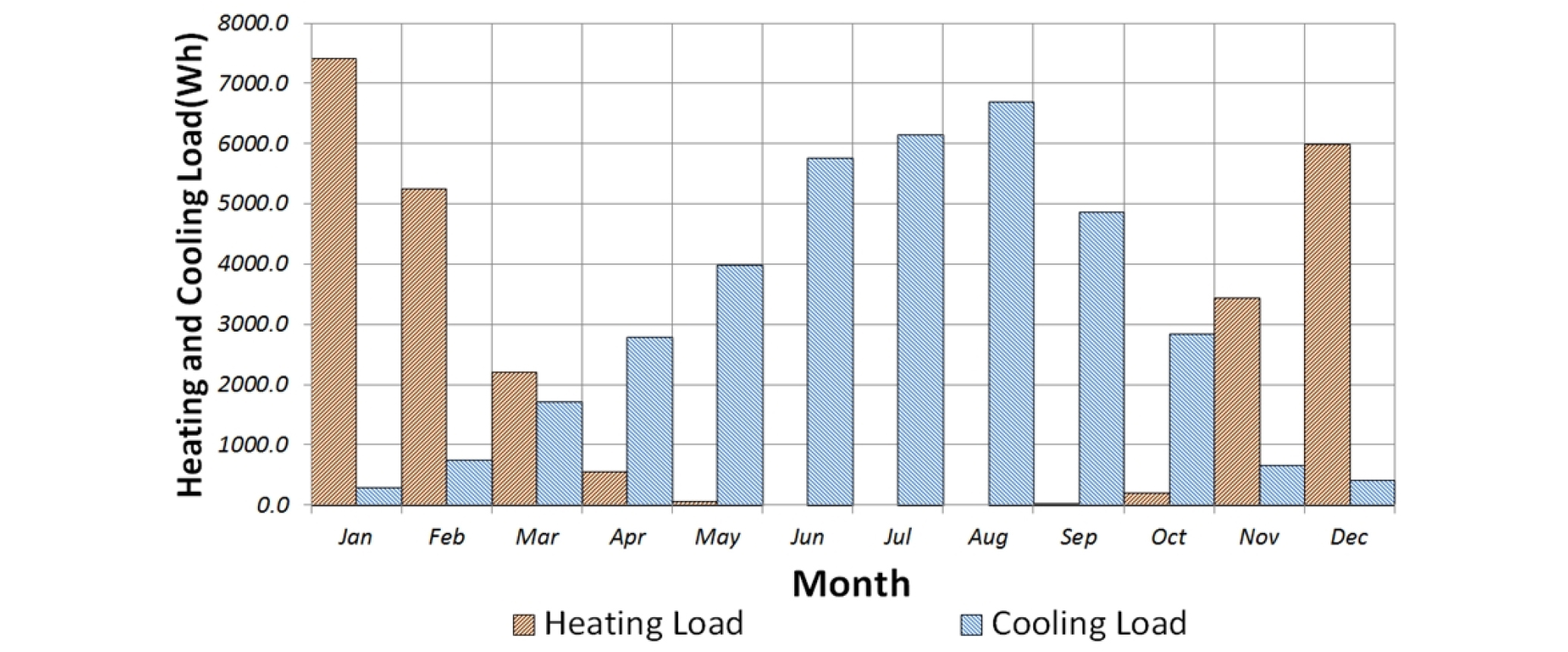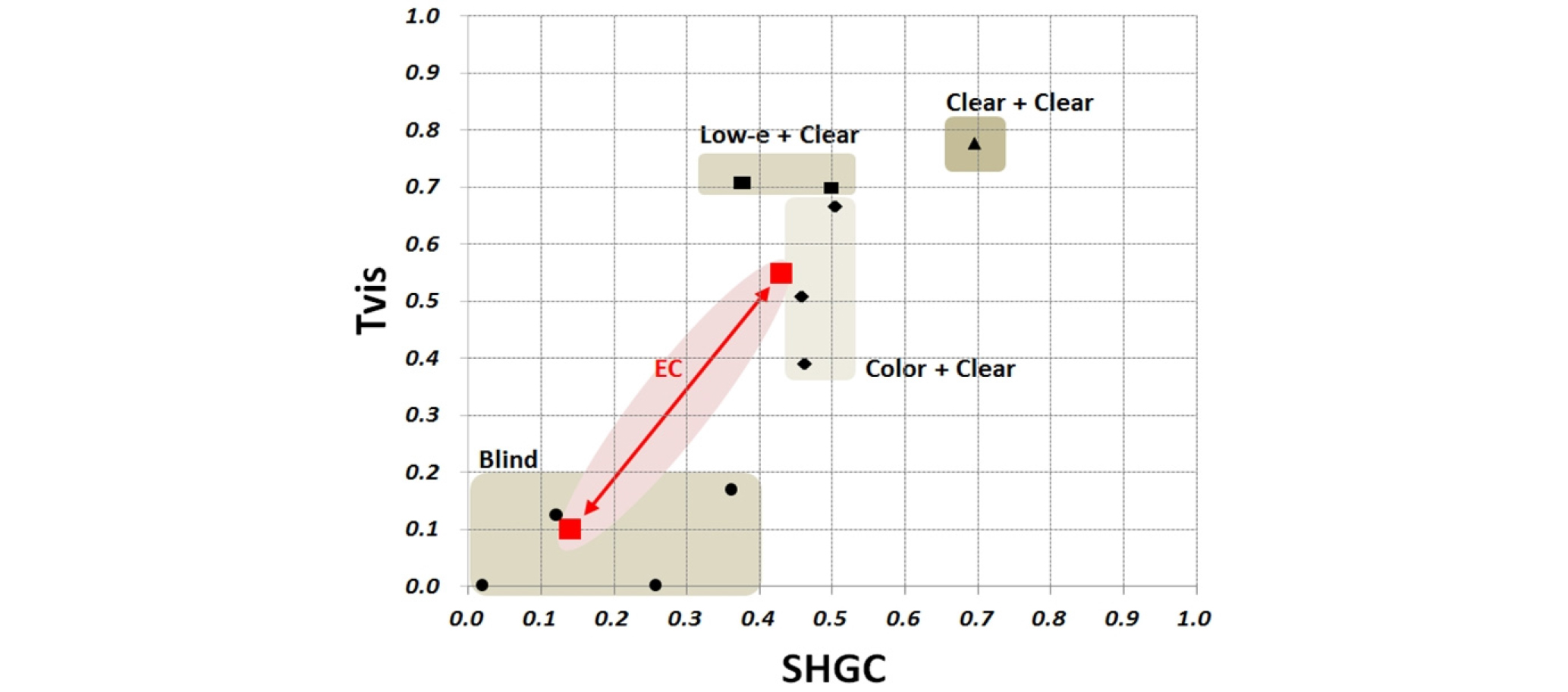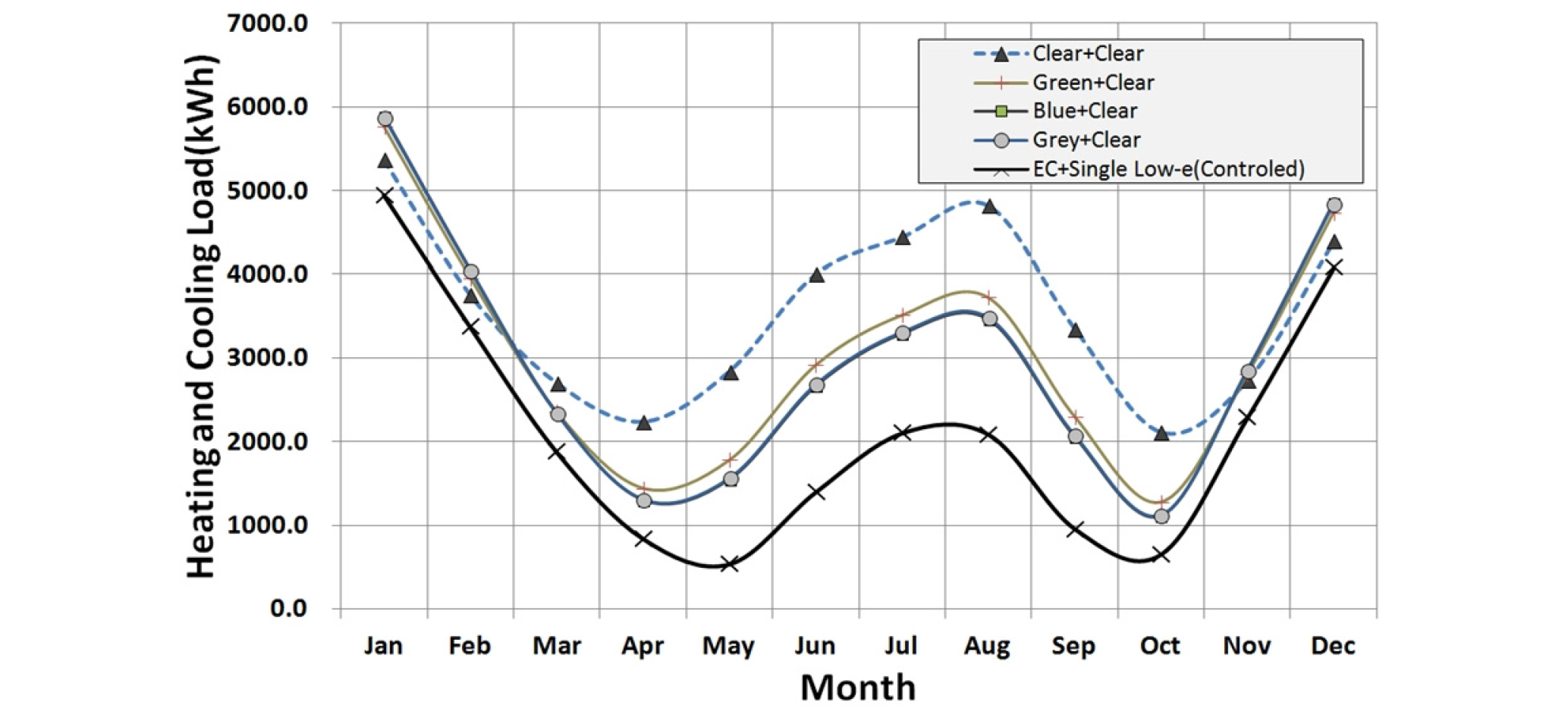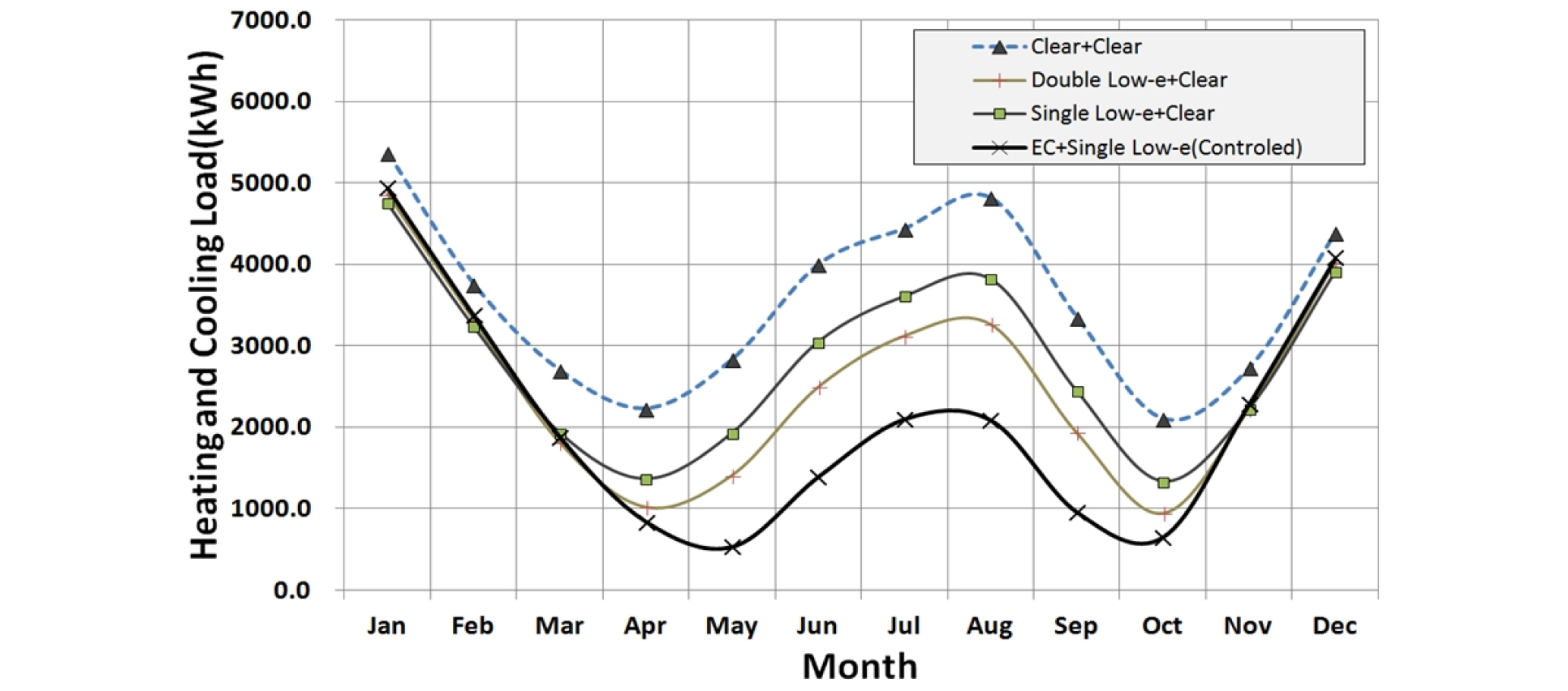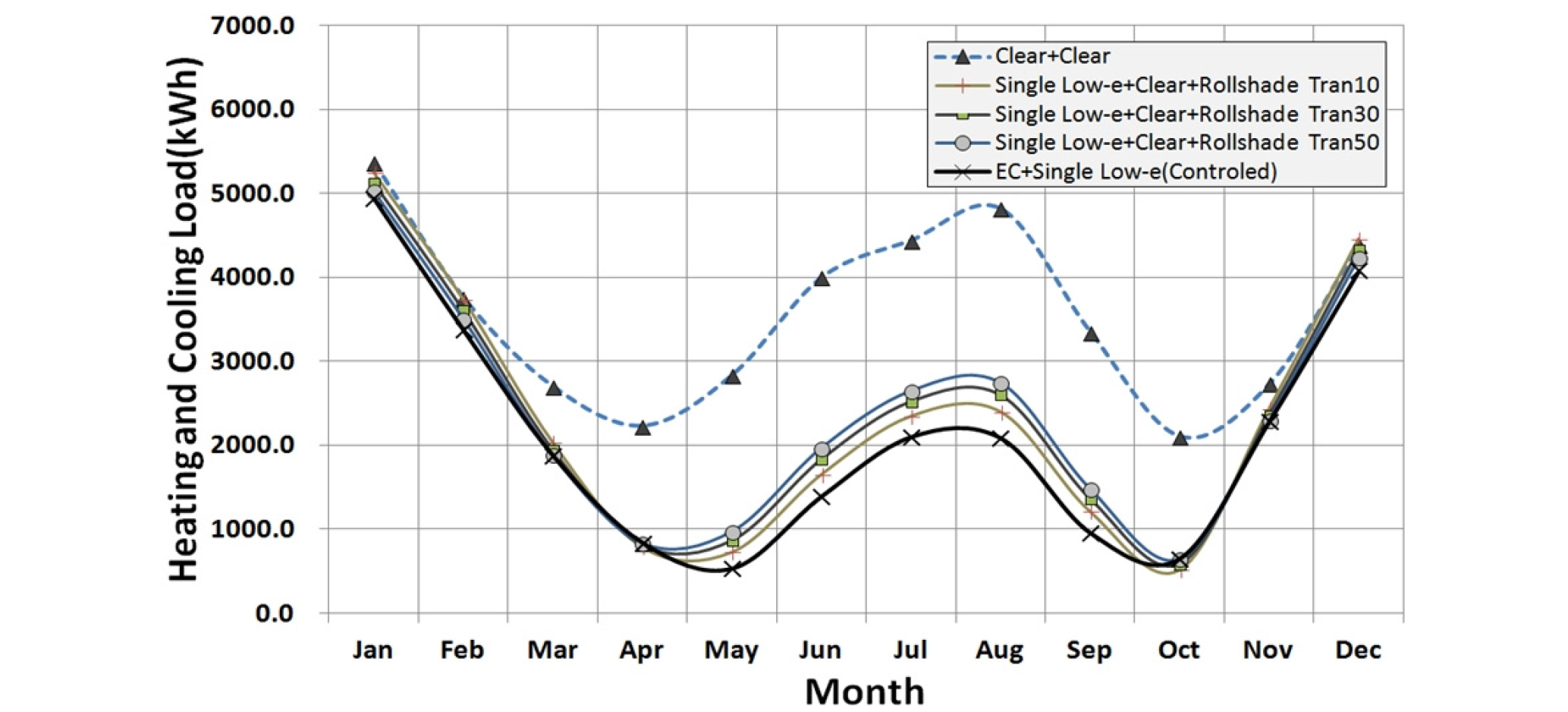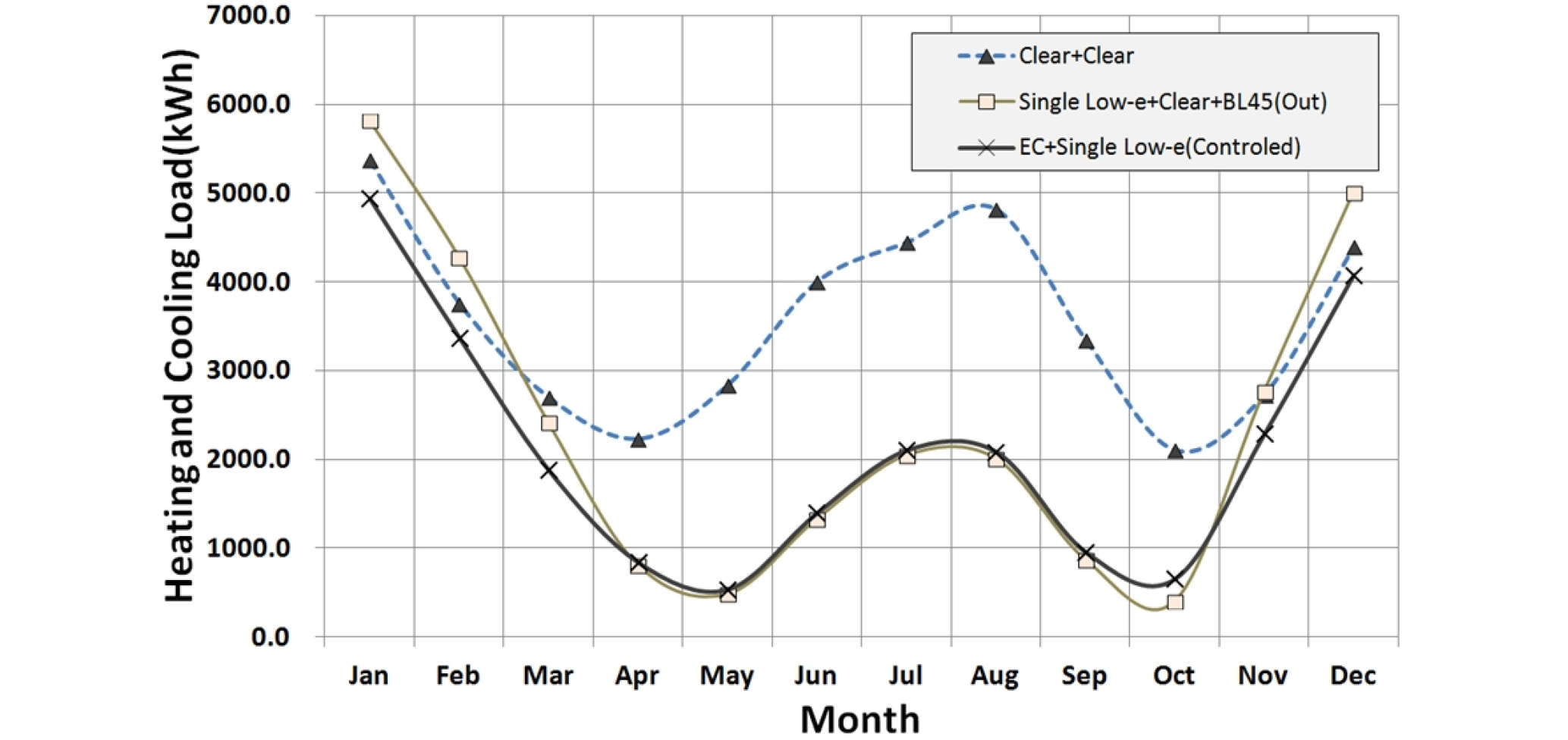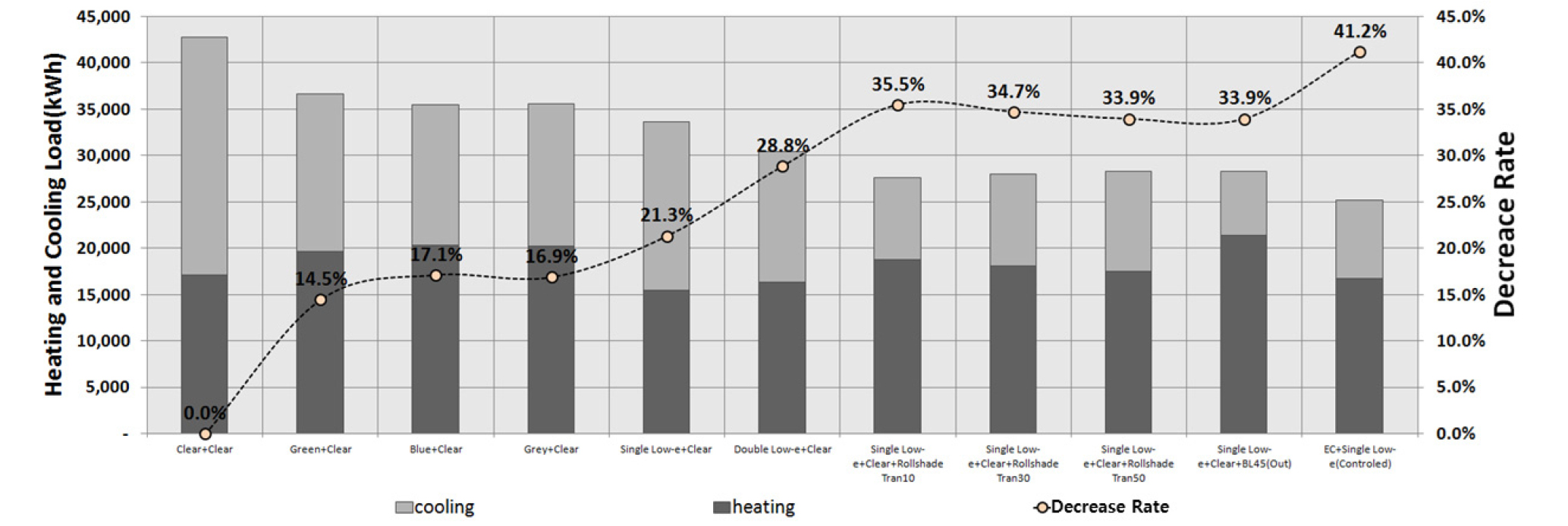Introduction
Methodology
Optical Properties of Electrochromic Glass
Simulation Analytical Model Overview
Glass Composition for Comparative Performance Analysis
Comparison of Annual Heating and Cooling Load
Conclusion
Introduction
Windows in structures are the only glazing in the facade that can either pass or block solar radiation. Transmission and blocking of solar radiation are very important in South Korea, where weather in the summer and winter seasons is clearly differentiated [1]. Recently, research on electrochromic glass, as a smart glass for solar control, has been conducted actively for energy saving. Electrochromic glass is characterized by the possibility of controlling not only the transmittance of the entire solar spectrum (Tsol) but also the visible transmittance (Tvis) [2]. The transmittance of photochromic glass, which is a chrome-family glass, varies depending on the amount of light, whereas that of thermochromic glass changes according to the temperature of the surroundings. The disadvantages of such thermochromic glass are a reduced energy-savings effect in variable environments such as that of South Korea, which four seasons, because its transmittance varies with a fixed transmittance depending on the surrounding environment and its response is slow. In the case of polymer dispersed liquid crystal (PDLC) windows, it is difficult to adjust the window to the desired transmittance because it has the disadvantages of requiring a continuous supply of power and only two steps of optical characteristics, i.e., transparency and translucency. Furthermore, because there is only a negligible difference between transparency and translucency in the solar heat gain coefficient (SHGC), it may be appropriate for interior use to protect privacy but may not be suitable for exterior use [3].
On the other hand, the optical characteristics of electrochromic glass can be changed in steps by changing the electrical polarity, either positive (+) or negative (−). In addition, the most outstanding feature of electrochromic glass is the memory effect in that the driving energy consumption can be kept at a minimum because it will be either colored or bleached once positive (+) or negative (−) electricity is applied and will maintain its state without requiring further application of electricity [4, 5]. In addition, it can contribute to building energy savings as a material for exterior windows due to its ability to have the necessary transmittance characteristics during the heating and cooling seasons because the difference in Tsol and Tvis between the colored and bleached states is clear. Accordingly, the present study analyzed the building energy performance of an office building with electrochromic glass installed.
Methodology
As a basic step to analyze the effect of electrochromic glass installation in the windows on building energy performance, the transmittance, reflectance, and absorptance of electrochromic glass were measured at different spectral regions using a spectrum analyzer. The measured data were entered into the LBNL Optic5 and Window7.2 programs and the visible transmittance and SHGC of the multilayer glass were derived. In addition, an analysis model of a square office building was constructed using the EnergyPlus 8.2 program to analyze the building energy performance of electrochromic glass, and the energy-saving performance of electrochromic glass windows was analyzed by examining the heating and cooling energy savings obtained by the installation of electrochromic glass, general transparent windows, low-e windows, and window blinds.
Optical Properties of Electrochromic Glass
To analyze the optical characteristics of electrochromic glass, a 50 mm × 50 mm sample was constructed, and the transmittance and reflectance in the wavelength range of 0.3 µm to 2.5 µm (in 0.005 µm increments) were measured using a spectrum analyzer from the Korea Conformity Laboratories (KCL).
Table 1. Optical properties of Electrochromic
The electrochromic glass consisted of a transparent conductive object, which allowed electrical flow on the glass surface, tungsten oxide (WO), which is a discolored layer, an electrolyte in which ions can be conducted, and bus-bar electrodes formed with silver paste to allow the flow of electricity. The performance of the electrochromic glass was measured when it was in maximally bleached and colored states, and the voltages in those states were measured with the maximum voltages of −2 V and +2 V applied. Transmittance and reflectance data measured using a spectrum analyzer were entered into the Optic 5.1 program of the Lawrence Berkeley National Laboratory (LBNL), and solar transmittance and solar reflectance over the entire solar spectrum as well as visible transmittance and visible reflectance in the visible light region were derived (presented in Table 1) [6]. As mentioned previously, the analysis results showed large differences in Tsol and Tvis between the colored and bleached states. Tsol was adjustable from 48.1% before the application of electricity to 6.5% through the discoloration by the application of electricity, and Tvis was adjustable from 64.8% to 12%, as shown in Table 1.
Simulation Analytical Model Overview
An analysis model of a square office building was constructed using the EnergyPlus 8.2 simulation program to evaluate the heating and cooling load performances of the electrochromic glass, as shown in Figure 1. Because of the advantages of the EnergyPlus program, allowing the calculation of the detailed heat transfer of the window by conduction, convection, and radiation based on the heat balance equation and the calculation of the transmission, reflection, and absorption characteristics of solar radiation, the program is suitable for evaluating the influence of bleaching and coloration of electrochromic glass on building energy [7-10]. The square office building model was 19 m wide and long, included four interior zones formed at each azimuth within 4.5 m of the exterior wall, and had a window-to-wall ratio (WWR) of 60%.
Meteorological data of Seoul were used. The climatic conditions in Seoul have the characteristics of a continental climate. The annual temperature range reaches 30°C due to the influence of continental cold high pressure in winter and hot and humid oceanic air masses in summer (Figure 2). For the load profile, the “IdealLoadAirSystem” provided in EnergyPlus was applied, and the heating and cooling setup temperatures were set at 20°C and 27°C, respectively, according to the room temperature standard for the calculation of heating and cooling capacity based on the energy-saving design criteria of buildings [11].
Table 2. Thermal and optical properties of building elements
The composition of the exterior walls of the analysis model, which followed the energy-saving design criteria of buildings (2016), is shown in Table 2. The physical properties of the standard multilayer glass (6 mm clear + 12 mm air + 6 mm clear) used were thermal transmittance of 2.543 W/m2K, SHGC of 0.695, and visible transmittance of 0.777. The results of the heating and cooling load analysis with standard glass in the analysis model are shown in Table 3, which shows that the proportion of cooling of the model is higher with 40.5% heating and 59.5% cooling. Based on the present analysis model, cooling and heating loads with different types of glass were analyzed comparatively.
Table 3. Cooling and heating load portion of analytical model
| Division | Heating Load | Cooling Load |
| Total (Wh) | 25078.7 | 36855.4 |
| Rate (%) | 40.5% | 59.5% |
Glass Composition for Comparative Performance Analysis
The present study made a comparative analysis of the performance of glass and shading devices that have been commercialized to determine the level of performance of electrochromic glass in reducing heating and cooling loads. First, tinted glass, low-e glass, roller shades, external louvers, and electrochromic glass were multi-layered by each type and then the thermal insulation performance and optical characteristics were derived, as shown in Table 4. The analysis of Table 4 and Figure 3 showed that the SHGC of the electrochromic glass was similar to that of tinted glass when bleached and similar to that of external louvers in the coloration state. Accordingly, electrochromic glass has sufficient potential as a solar control device that can reduce the heating and cooling loads of buildings in climatic conditions in which the seasonal difference between summer and winter is as clear as it is in South Korea.
Table 4. Composition of glazing for comparative performance analysis
According to previous literature, the solar control devices in most domestic office buildings are used as permanent fixtures [12]. Accordingly, roller shades and external louvers, solar control devices used in the present study, were assumed to be used in a fixed state, and the transmittance of roller shades was classified into 10%, 30%, and 50% and applied due to their various types. On the other hand, electrochromic glass was assumed to be set as “bleached” in the winter season (Nov–Mar) and “colored” in the summer season (Apr–Oct), giving consideration to only the heating and cooling loads of the building.
Comparison of Annual Heating and Cooling Load
In the present chapter, the load reduction performance of electrochromic glass was determined through the analysis of annual heating and cooling loads by the glass types presented in Table 4. Annual heating and cooling loads were analyzed for only the exterior zones in the south, east, west, and north among the zones presented in Figure 1. Analysis samples were classified into the four groups of tinted glass, low-e glass, roller shades, and external louvers, and the glass composition of each group and the heating and cooling loads were compared.
First, Table 5 and Figure 4 show the results of a comparative analysis of heating and cooling loads between tinted glass and electrochromic glass. As shown in Table 5, the performance of electrochromic glass was best because it had the lowest heating and cooling loads of 25140.1 Wh. In terms of cooling loads, the reduction of cooling load of tinted glass is relatively superior because the SHGC of tinted glass is lower than that of transparent glass, but the performance was worse than that of electrochromic glass when it is colored. In terms of heating loads, the load of tinted glass was found to be higher than that of transparent glass due to the higher blocking of solar radiation by tinted glass. On the other hand, the SHGC of electrochromic glass when bleached was higher than that of transparent glass, but its performance in heating loads was found to be best due to low thermal transmittance due to the fact that it basically uses low-e glass. A limitation of the present study was that analysis was conducted by comparing only one composition of electrochromic glass to existing glass products, even though various combinations of electrochromic glass should be used for more detailed analysis.
Table 5. Comparison of heating and cooling load of Color and EC glazing
Second, Table 6 and Figure 5 show the comparison data of heating and cooling loads between low-e glass and electrochromic glass. Two types of low-e glass were used in the experiment, i.e., single low-e glass, which is most widely used in South Korea, and a high-performance double low-e glass, which has lower radiation factor than single low-e glass and low SHGC. The analysis results showed a superior performance of the electrochromic glass compared to those of the two types of low-e glass, as shown in Table 6.
Table 6. Comparison of heating and cooling load of Low-e and EC glazing
Analyzing Figure 5, the cause of the performance difference was determined to be that the cooling load reduction performance of the electrochromic glass in the colored state was superior to those of both types of low-e glass due to the low SHGC, even though the low-e glass was superior to the transparent glass in reducing cooling loads due to low SHGC. On the other hand, the double low-e glass, which has the best thermal insulation performance due to its lowest radiation factor during the winter season, was found to most significantly reduce heating loads. However, because the annual load is most significantly affected by cooling, the electrochromic glass, which had the best performance in reducing cooling load, was found to be most advantageous.
Table 7. Comparison of heating and cooling load of roll shade and EC glazing
Third, Table 7 and Figure 6 show the comparison data of heating and cooling loads between the roller shade and the electrochromic glass. The roller shade is the shading device that is most widely used in office buildings in South Korea. Due to the variety of roller shades, the present study analyzed three types of roller shades, i.e., 10%, 30%, and 50% transmittance shades. The analysis results showed that the performance of the electrochromic glass was best compared to the three types of roller shades. In terms of cooling loads, electrochromic glass was found to be slightly more advantageous than roller shades due to its low SHGC, even though roller shades can reduce cooling loads more than transparent glass.
Table 8. Comparison of heating and cooling load of Louver and EC glazing
In terms of heating loads, electrochromic glass was found to contribute more to the reduction of heating load than roller shades that are closed continuously because they can transmit solar radiation. In terms of cooling loads, the reason for the lower SHGC of electrochromic glass than of roller shades is that roller shades create a greenhouse effect by the radiation of some longwave radiation that does not escape to the outside because roller shades are installed on the inside to block solar radiation but electrochromic glass has a high effect of solar radiation blocking.
Fourth, Table 8 and Figure 7 show the results of the comparison between external louvers and electrochromic glass. The external louver is known to be the shading device that has the highest solar radiation blocking rate. The analysis results showed that the performance of the electrochromic glass was similar to that of external louvers in terms of cooling load. Even though the performance of external louvers was shown to be poor in terms of heating load because the solar radiation blocking rate of external louvers was consistently high even in the winter season, the performance of the electrochromic glass was largely better than that of the external louvers due to the transmission of solar radiation by the discoloration during the winter season. Therefore, the performance of electrochromic glass was determined to be superior to even that of external louvers.
Figure 8 shows the results of the comprehensive comparison among tinted glass, low-e glass, roller shades, and external louvers. The analysis results showed that the performance of electrochromic glass was best because it can reduce heating and cooling loads by 41.2% compared to transparent glass.
Conclusion
The purpose of the present study was to evaluate the performance of the electrochromic glass developed by the investigators of the present study in reducing heating and cooling loads when used in office buildings in South Korea compared to existing tinted glass, low-e glass, roller shades, and external louvers. The following conclusions were obtained in the study.
First, compared to tinted glass and low-e glass without shading devices, electrochromic glass has a larger effect on reducing heating and cooling loads without separate shading devices because its own optical characteristics can be controlled.
Second, compared to existing roller shades, which are most widely used in South Korea, electrochromic glass has both superior performance of cooling load reduction because of lower SHGC than roller shades when colored and also superior performance for heating load compared with roller shades that are kept closed constantly when the discoloration state is maintained in the winter season.
Third, it was confirmed that electrochromic glass has sufficient potential as a solar radiation control device because the performance of electrochromic glass in its coloration state was found to be similar to that of external louvers, which are known for their best solar radiation blocking rate.
In the present study, electrochromic glass was controlled in only the two modes of coloration and discoloration and in the two seasons of winter and summer, but control methods from various perspectives, such as building energy, daylight performance, and visual comfort, will be employed in future studies.



